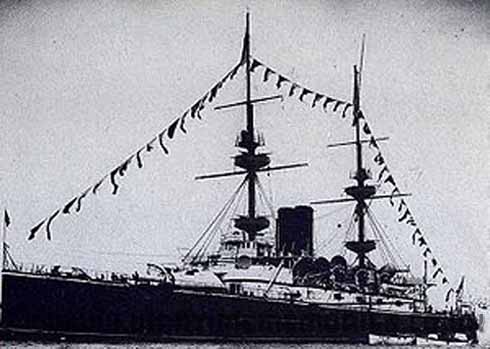1st July 1914 HMS Mars 
HMS Mars
HMS Mars. (1897 - 1921)
Majestic Class - pre-dreadnought Battleships.
The Majestic class was a class of pre-dreadnought battleships, built under the Spencer Programme (named after the First Lord of the Admiralty, John Poyntz Spencer, 5th Earl Spencer) of 8 December 1893, that sought to counter the growing naval strength of France and the Russian Empire. With nine units commissioned, they were the largest class of battleships in history in terms of the number of member ships. This class was designed by Sir William White.
- Ships in Majestic Class
- Caesar
- Hannibal
- Illustrious
- Jupiter
- Magnificent
- Majestic
- Mars
- Prince George
- Victorious
When the lead ship, Majestic, was launched in 1895, at 421 ft (128 m) long and with a full-load displacement of 16,000 tons, she was the largest battleship ever built at the time. The Majestics were considered good seaboats with an easy roll and good steamers, although they suffered from high fuel consumption. They began life as coal-burners, but HMS Mars in 1905,1906 became the first battleship converted to oil-burning, and the rest were similarly converted by 1907,1908. The class was the last to have side-by-side funnels, with successor battleship classes having funnels in a line.
Except for Caesar, Hannibal, and Illustrious, they had a new design in which the bridge was mounted around the base of the foremast behind the conning tower to prevent a battle-damaged bridge from collapsing around the tower. Although the earlier ships had pear-shaped barbettes and fixed loading positions for the main guns, Caesar and Illustrious had circular barbettes and all-around loading for their main guns, which established the pattern for future classes.
Although Harvey armour had been used on battleship HMS Renown of the Centurion class, in the Majestics it was used in an entire class of British battleships for the first time. It allowed equal protection with less cost in weight compared to previous types of armour, allowing the Majestic class to have a deeper and lighter belt than previous battleships without any loss in protection.
The Majestics were given a new gun, the 46-ton BL 12 inch (305 mm) Mk VIII /35 gun. They were the first new British battleships to mount a 12 inch main battery since the 1880s. The new gun was a significant improvement on the 13.5 inch (343 mm) gun which had been fitted on the Admiral and Royal Sovereign classes that preceded the Majestics and was lighter. This saving in weight allowed the Majestic class to carry a secondary battery of twelve 6 inch (152 mm) 40-calibre guns, a larger secondary armament than in previous classes.
The Majestics were to be a benchmark for successor pre-dreadnoughts. While the preceding Royal Sovereign-class battleships had revolutionized and stabilised British battleship design by introducing the high-freeboard battleship with four main-battery guns in twin mountings in barbettes fore and aft, it was the Majestics that settled on the 12 inch (305 mm) main battery and began the practice of mounting armoured gunhouses over the barbettes; these gunhouses, although very different from the old-style, heavy, circular gun turrets that preceded them, would themselves become known as "turrets" and became the standard on warships worldwide.
More directly, the Majestic design itself also was adapted by the Imperial Japanese Navy for its own Shikishima-class pre-dreadnoughts,[6] as well as Mikasa, which was largely based on the Shikishimas.
World War 1 Service
As battleship
With war appearing to be imminent, the Royal Navy undertook a precautionary mobilization on 27 July 1914. As part of this, Mars and her sister ships HMS Hannibal, HMS Magnificent, and HMS Victorious formed the 9th Battle Squadron, which was based in the Humber under the Admiral of Patrols. Mars was serving as a guard ship at the Humber when World War I began in August 1914, and continued in that duty after the 9th Battle Squadron was dissolved on 7 August 1914.
Mars was transferred to the Dover Patrol on 9 December 1914, and was based at Dover briefly before moving to Portland on 11 December 1914. She was based at Portland until February 1915.
The Majestic-class ships were by then the oldest and least effective battleships in service in the Royal Navy. In February 1915, Mars transferred to Belfast, where she paid off on 15 February 1915. In March and April 1915 she was disarmed there by Harland and Wolff, retaining only four of her 6-inch (152-mm) guns and some lighter guns; her 12-inch (305-mm) guns were taken to arm the new Lord Clive-class monitors HMS Earl of Peterborough and HMS Sir Thomas Picton.[10] After that, she was laid up in Loch Goil in April 1915.
As troopship
In September 1915, Mars recommissioned to serve as a troopship in the Dardanelles campaign. Mars and her similarly disarmed sister ships Hannibal and Magnificent, also acting as troopships, arrived at Mudros on 5 October 1915. At the Dardanelles, Mars took part in the evacuation of Allied troops from Anzac Cove on 8 December 1915 and 9 December 1915 and from West Beach at Cape Helles on 8 January 1916 and 9 January 1916. During the West Beach evacuation, Mars was covered by what had once been her 12-inch (305-mm) guns, now mounted on monitor Sir Thomas Picton.
Decommissioning and subsidiary duties
Mars returned to Devonport in February 1916, then paid off at Chatham, where she underwent a refit for conversion to a harbor depot ship. She recommissioned as a harbor depot ship on 1 September 1916, and served in this capacity at Invergordon until July 1920.
Disposal
Mars was placed on the sale list at Invergordon on 7 July 1920. She was sold for scrapping on 9 May 1921 and left Invergordon for scrapping at Briton Ferry in November 1921.
John Doran
If you can provide any additional information, please add it here.





